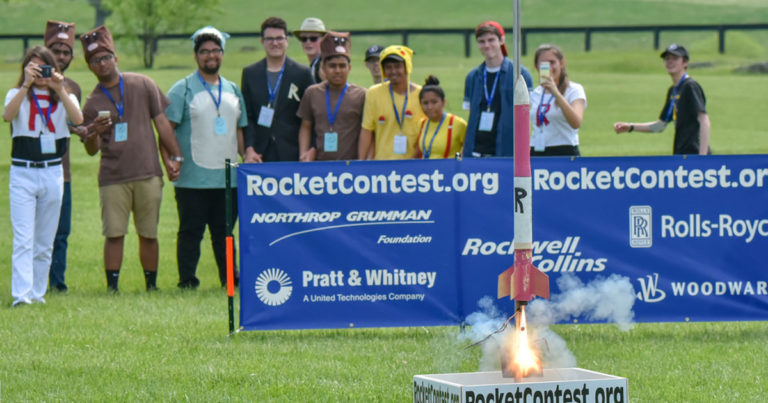Why Scouts, Venturers will want to enter the world’s largest student rocketry contest

Here’s a way for young people to have a blast while gaining first-hand insight into the science, technology, engineering and math (or STEM) skills behind rocketry.
It’s called the Team America Rocketry Challenge, and it’s the world’s largest student rocketry contest. Scouts and Venturers, even those with little or no experience building and launching their own rocket, are invited to enter.
Teams of three to 10 students (in grades 6 through 12) will design, build and test a rocket. When it’s ready, they’ll submit their qualification flights where the goal is to launch three raw eggs 856 feet into the air and return them safely to the ground.
Teams are penalized if the eggs break, if the rocket’s max altitude is too high or too low, or if the flight lasts too long or not long enough.
The top 100 teams nationwide — from an expected pool of about 900 teams — go to the national finals in May 2019 near Washington, D.C. At this event, $100,000 in cash and prizes is on the line for teams that perform well.
But it gets even cooler.
The team that wins the national finals gets an all-expenses-paid trip to the international rocketry challenge in June 2019 in Paris.
These U.S. representatives will have big shoes to fill; the Americans are riding a four-year winning streak in the event.

How to enter and learn more
But we’re getting ahead of ourselves.
Before your team or crew is ready for liftoff, review this newcomers page on the Team America Rocketry Challenge site.
Registration closes Dec. 1, and then teams have until April 8 to submit their qualification flights.
To learn more, I spoke with Jeremy Davis, Team America Rocketry Challenge’s manager of strategy and innovation. He recommends that teams have their initial design finalized by the end of December. That way they’ll do their building when it’s too cold to launch in most parts of the country.
“They can spend those months building so that, as soon as the weather is good, they can start launching and doing their test flights,” Davis says.
Davis says the coolest part of the competition is that it teaches not only physics and engineering skills, but also planning and organizational skills. It’s not hard to see how this event intersects perfectly with Scouting.
Davis has heard from several troops that work on their rocket during meetings. They make it a structured part of their troop activity.
“It goes hand in hand with what Scouting tries to teach with leadership skills and organization,” Davis says. “Students are required to design, build and test themselves. There’s no kit. There’s no answer to the solution.”

What one troop is saying
I wanted to hear from a troop that had participated in the competition, so I contacted Carl Curling, adult coordinator for the team fielded by members of Troop 295 of Woodbridge, Va.
Curling tells me this is the team’s 11th time competing. Their best finish so far: 21st in 2017.
The Scouts average about 35 test flights a year, and “very few of the launches are entirely successful,” Curling says. “But very few of them are major failures, either.”
Each test is a learning opportunity. After they gather the rocket (or, in some cases, what’s left of it), Curling explains how concepts of thrust, drag and design affected the end result.
But Scouts learn much more than that.
“Of course, most of the team members have completed or are pursuing the Space Exploration merit badge,” he says. “But more than that, being on a team of Scouts has helped them bond together, solve problems that they couldn’t even have conceived of earlier and reinforced many of the Scouting values.
What happens if Scouts want to enter but don’t know an expert like Carl Curling?
“The National Association of Rocketry has hundreds of mentors all over the United States willing to help Team America Rocketry Challenge teams, so the initial lack of expertise can be overcome,” Curling says.
Even if a troop or crew doesn’t form a competition team this year, Curling says Scouting units benefit from building and launching rockets as a team.
“This is beyond STEM,” he says. “It is STEAM — with the added “Art” of the craftsmanship of building a beautiful model and seeing it fly. So many skills are developed in the process, and so much fun can be had along the way. Go to your local hobby or craft store, get some kits and start flying.”
Why Scouts, Venturers will want to enter the world’s largest student rocketry contest
